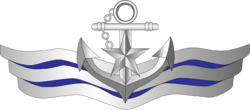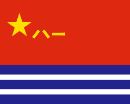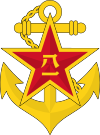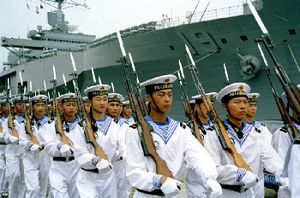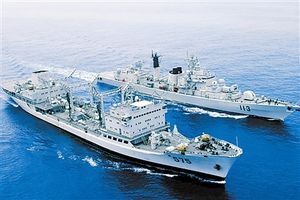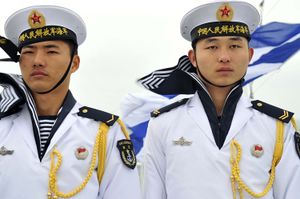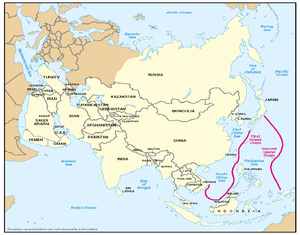بحرية جيش التحرير الشعبي
بحرية جيش التحرير الشعبي (PLAN أو PLA Navy)، هي فرع القوات البحرية من جيش التحرير الشعبي، القوات المسلحة الصينية. The PLAN can trace its lineage to naval units fighting during the Chinese Civil War and was established in September 1950. Throughout the 1950s and early 1960s, the Soviet Union provided assistance to the PLAN in the form of naval advisers and export of equipment and technology.[5] Until the late 1980s, the PLAN was largely a riverine and littoral force (brown-water navy). However, by the 1990s, following the fall of the Soviet Union and a shift towards a more forward-oriented foreign and security policy, the leaders of the Chinese military were freed from worrying over land border disputes, and instead turned their attention towards the seas. This led to the development of the People's Liberation Army Navy into a green-water navy by 2009.[6] Before the 1990s the PLAN had traditionally played a subordinate role to the People's Liberation Army Ground Force.
In 2008, General Qian Lihua confirmed that China plans to operate a small fleet of aircraft carriers in the near future, but for the purpose of regional defence as opposed to "global reach".[7] As of 2013 PLA officials have also outlined plans to operate in the first and second island chains.[8] Chinese strategists term the development of the PLAN from a green-water navy into "a regional blue-water defensive and offensive navy."[9]
The People's Liberation Army Navy is composed of five branches; the Submarine Force, the Surface Force, the Coastal Defense Force, the Marine Corps and the Naval Air Force.[10] With a personnel strength of 240,000 personnel, including 15,000 marines and 26,000 naval air force personnel[4], it is the second largest navy in the world in terms of tonnage, only behind the United States Navy, and has the largest number of major combatants of any navy.
المهام
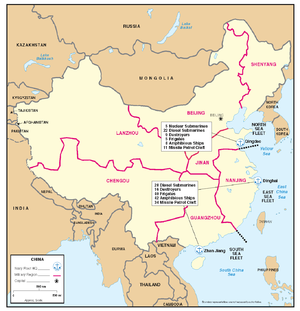
أوقات السلم:
- القيام بدوريات بحرية في المياه الاقليمية
- التواجد في المياه الاقليمية وحماية المنشآت الموجودة بها
- محاربة القرصنة، التهريب، والبحث والانقاذ
- تحقيق الأمن في المياه الاقليمية
- توفير الدعم اللوجستي للمقاتلات وحاميات الجزر.
- تأمين خطوط الاتصالات البحرية.
أوقات الحرب:
- الدفاع عن البحار الاقليمية
- الحصار أو حماية الطرق الحيوية للسفن ونقاط الاختناق
- القيام بالنقل التكتيكي، الدعم، والعمليات البرمائية للقوات البرية
- الدفاع الجوي
- عمليات مقاومة الغواصات
- الالتحام بسفن الأعداء
- توفير الدعم اللوجستي للمقاتلين وحاميات الجزر.
التاريخ
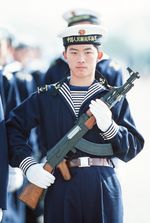
الخمسينيات والستينيات
السبعينيات والثمانيينات
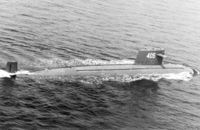
القرن 21
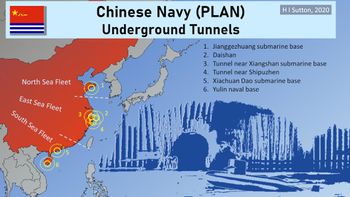
الوضع الحالي
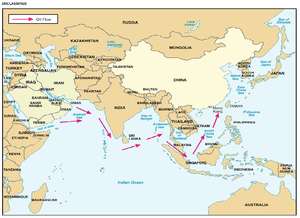
الاستراتيجية، الخطط والأولويات
عمليات مكافحة القرصنة 2008
الثورة الليبية 2011
التنظيم

The PLAN is organized into several departments for purposes of command, control and coordination. Main operating forces are organized into fleets, each with its own headquarters, a commander (a Rear Admiral or Vice Admiral) and a Political Commisar. All PLAN headquarters are subordinate to the PLA Joint Staff Department and the Chairman of the Central Military Commission.
الأساطيل
The People's Liberation Army Navy is divided into three fleets:[12]
- The North Sea Fleet, based in the Yellow Sea and headquartered in Qingdao, Shandong Province.
- The East Sea Fleet, based in the East China Sea and headquartered in Ningbo, Zhejiang Province.
- The South Sea Fleet, based in the South China Sea and headquartered in Zhanjiang, Guangdong Province.
Each fleet consists of surface forces (destroyers, frigates, amphibious vessels etc.), submarine forces, coastal defence units, and aircraft.
الأفرع
PLAN Submarine Force
The People's Liberation Army Navy Submarine Force is one of five branches in the navy and consists of all submarines both nuclear-powered and conventionally-powered in service with the PLAN. They are organised into flotillas spread across the three main fleets.[13]
The PRC is the last of the permanent members of the United Nations Security Council which has not conducted an operational ballistic missile submarine patrol, because of institutional problems.[14] It operates a fleet of 68 submarines.
PLAN Surface Force
The People's Liberation Army Surface Force is one of five branches in the navy and consists of all surface warfare ships in service with the PLAN. They are organised into flotillas spread across the three main fleets.[15]
PLAN Coastal Defence Force
The PLAN Coastal Defence Force is a land-based fighting force and branch of the PLAN[16] with a strength of around 25,000 personnel. Also known as the coastal defense troops, they serve to defend China's coastal areas from invasion via amphibious landings or air-attack. Throughout the 1960s to 1980s, the Coastal Defense Force was focused on defending China's coast from a possible Soviet sea-borne invasion. With the fall of the Soviet Union, the threat of an amphibious invasion of China has diminished and therefore the branch is often considered to no-longer to be a vital component of the PLAN, especially as the surface warships of the PLAN continue to improve in terms of anti-ship and air-defence capabilities.
Today the primary weapons of the coastal defense troops are the HY-2, YJ-82, and C-602 anti-ship missiles.
PLAN Marine Corps
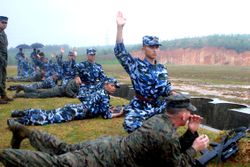
The PLAN Marine Corps was originally established in the 1950s and then re-established in 1979 under PLAN organisation. It consists of around 12,000 marines organised into two 6000-man brigades and is based in the South China Sea with the South Sea Fleet. The Marine Corps are considered elite troops, and are rapid mobilization forces trained primarily in amphibious warfare and as Paratroopers to establish a beachhead or act as a fighting spearhead during operations against enemy targets. The marines are equipped with the standard Type 95 Assault Rifle as well as other small arms and personnel equipment, and a blue/littoral camouflage uniform as standard. The marines are also equipped with armoured fighting vehicles (including amphibious light tanks such as the Type 63), artillery, and anti-aircraft artillery systems and short range surface-to-air missiles.
With the PLAN's accelerating efforts to expand its capabilities beyond territorial waters, it would be likely for the Marine Corps to play a greater role in terms of being an offshore expeditionary force similar to the USMC and Royal Marines.
The People's Liberation Army Naval Air Force is the "air force" of the PLAN and has a strength of around 25,000 personnel and 690 aircraft. It operates similar aircraft to the People's Liberation Army Air Force, including fighter aircraft, bombers, strike aircraft, tankers, reconnaissance aircraft, electronic warfare aircraft, maritime patrol aircraft, transport aircraft, and helicopters of various roles. The PLA Naval Air Force has traditionally received older aircraft than the PLAAF and has taken less ambitious steps towards mass modernization. Advancements in new technologies, weaponry and aircraft acquisition were made after 2000. With the introduction of China's first aircraft carrier, Liaoning the Naval Air Force is for the first time conducting aircraft carrier operations.[17] Naval Air Bases includes:
- North Sea Fleet: Dalian, Qingdao, Jinxi, Jiyuan, Laiyang, Jiaoxian, Xingtai, Laishan, Anyang, Changzhi, Liangxiang and Shan Hai Guan
- East Sea Fleet: Danyang, Daishan, Shanghai (Dachang), Ningbo, Luqiao, Feidong and Shitangqiao
- South Sea Fleet: Foluo, Haikou, Lingshui, Sanya, Guiping, Jialaishi and Lingling
Relationship with other maritime organizations of China
The PLAN is complemented by paramilitary maritime services such as the China Coast Guard. The Chinese Coast Guard was previously not under an independent command, considered part of the armed police, under the local (provincial) border defense force command, prior to its reorganization and consolidation as an unified service. It was formed from the integration of several formerly separate services (such as China Marine Surveillance (CMS), Hai Guang, People's Armed Police and sea militia). The CMS performed mostly coastal and ocean search and rescue or patrols. The CMS received quite a few large patrol ships that significantly enhanced their operations, while Hai Guang, militia, police and other services operated hundreds of small patrol craft. For maritime patrol services, these craft are usually quite well armed with machine guns and 37mm antiaircraft guns. In addition, these services operated their own small aviation units to assist their maritime patrol capabilities, with Hai Guang and CMS operating a handful of Harbin Z-9 helicopters, and a maritime patrol aircraft based on the Harbin Y-12 STOL transport.
Every coastal province has 1 to 3 Coast Guard squadrons:
- 3 Squadrons: Fujian, Guangdong
- 2 Squadrons: Liaoning, Shandong, Zhejiang, Hainan, Guangxi
- 1 Squadron: Heibei, Tianjin, Jiangsu, Shanghai
الرتب
The ranks in the People's Liberation Army Navy are similar to those of the People's Liberation Army Ground Force. The current system of officer ranks and insignia dates from 1988 and is a revision of the ranks and insignia used from 1955 to 1965. The rank of Hai Jun Yi Ji Shang Jiang (First Class Admiral) was never held and was abolished in 1994. With the official introduction of the Type 07 uniforms all officer insignia are on either shoulders or sleeves depending on the type of uniform used. The current system of enlisted ranks and insignia dates from 1998.
التعبئة

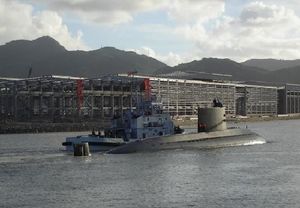
| Type | Nr. Planned/ Building |
Nr. Active |
Nr. in Reserve |
|---|---|---|---|
| Submarines | |||
| Nuclear Ballistic Missile Submarines | 3 | 4 | |
| Nuclear Attack Submarines | 4-6 | 5 | 2 |
| Conventional Ballistic Missile Submarines | 0 | 1 | |
| Conventional Attack Submarines | 1 | 47 | |
| Total Submarines | 8-10 | 57 | 2 |
| Principal Surface Combatants | |||
| Aircraft Carriers | 3 | 0 | |
| Destroyers | 26 | ||
| Frigates | 1 | 51 | |
| Total Principal Surface Combatants | 4 | 77 | |
| Coastal Warfare Vessels | |||
| Missile Boats | 132 | 110-120 | |
| Torpedo Boats | 20 | 150 | |
| Gun Boats | 160 | 100 | |
| Submarine Chasers | 75 | 20 | |
| Total Coastal Warfare Vessels | ~387 | ~380-390 | |
| Amphibious Warfare Vessels | |||
| Landing Platforms | 1 | 1 | |
| Landing Ships | 83 | ||
| Landing Craft | 370-480 | ||
| Total Amphibious Warfare Vessels | 1 | ~454-564 | |
| Mine Warfare Vessels | |||
| Mine Warfare Ships | 27 | 42 | |
| Mine Warfare Drones | 4 | 26 | |
| Total Mine Warfare Vessels | 31 | 68 | |
| Total Auxiliary/Support Vessels | ~153 | ||
| Total All Vessels | 12+ | ~1159-1269 | 450+ |
| Total Combat Vessels | 12+ | ~632 | 420+ |
Note: "Total Combat Vessels" counts only submarines, principal surface combatants, coastal warfare vessels, mine warfare ships, landing platforms and ships. These are vessels that would normally be commissioned and excludes landing craft, mine warfare drones and auxiliary/support vessels. All numbers are approximate.
السفن
الغواصات
السلاح
الطائرات
الطيران البحري
| الطائرة | المنشأ | النوع | الطراز | في الخدمة | هوامش |
|---|---|---|---|---|---|
| طائرة ثابتة الأجنحة | |||||
| Shenyang J-11BH/S | الصين | مقاتلة | ج-11 | 24 | Chinese developed fighter with airframe based on the Su-27 |
| Chengdu J-10 | الصين | مقاتلة | J-10, J-10AS, J-10SH[18] | 20 | |
| Xian JH-7A Flounder | الصين | غارة بحرية | JH-7A | 35[18] | |
| Shenyang J-8II Finback – | الصين | مقاتلة | ج-8 | 48[18] | |
| Chengdu J-7D/E Fishbed | الصين | اعتراضية | J-7 | 30[18] | |
| Sukhoi Su-30 MK2 Flanker | روسيا الصين |
مقاتلة | Su-30MKK2/33 | 24[18] | |
| Nanchang Q-5 Fantan | الصين | قصف خفيف | أ-5 | 30 | |
| Xian H-6 | الصين | قصف استراتيجي | H-6D | 16[18] | |
| Shaanxi Y-8MPA | الصين | دورية | Y-8 MPA | 6[18] | An-12 licensed copy |
| Shaanxi Y-8 | الصين | AEW | Y-8 ELINT[18] | 2 | |
| Harbin SH-5 | الصين | ASW | SH-5 | 3 | |
| Shenyang JianJiao JJ-6 Farmer | الصين | تدريب | JJ-6 | 30[18] | |
| Xian Y-7 | الصين | نقل متوسط | Y-7 | 10 | a variant of Antonov An-24 Coke |
| Shijiazhuang Y-5 | الصين | light utility aircraft | Y-5 | 3 | |
| JF-15 | الصين | Multirole combat aircraft | JF15 | 50 ordered[18] | |
| Hongdu JL-8 | الصين | تدريب نفاث/ هجوم خفيف | JL-8 | 12[18] | |
| Guizhou JL-9 | الصين | تدريب نفاث/ هجوم | JL-9 | 12[18] | |
| مروحيات | |||||
| Chenghe Z-8 | الصين | AEW | Z-8 | 26[18] | Aérospatiale SA 321 Super Frelon variant |
| Harbin Z-9 | الصين | ASW/SAR | Z-9 | 21 | Z-9C |
| Mil Mi-8 Hip | الاتحاد السوڤيتي | مروحية نقل متوسطة | مي-8 | 8 | |
| Kamov Ka-28 Helix | الاتحاد السوڤيتي | ASW | Ka-28 | 12 | 6 ordered [18] |
| Eurocopter AS365 Dauphin | مروحية مهاجة | AS365N | 3[18] | ||
الأسطول
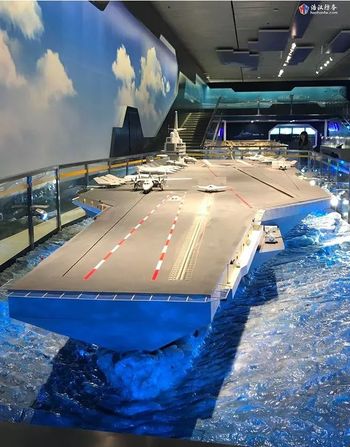
انظر أيضاً
- قائمة سفن البحرية الصينية العاملة
- القوات البحرية لجيش التحرير الشعبي
- القوات الجوية لجيش التحرير الشعبي
- طائرات القوات البحرية لجيش التحرير الشعبي
- القوات الجوية البحرية لجيش التحرير الشعبي
- حاملة الطائرات السوڤيتية ڤارياگ
- بحرية تايوان
المصادر
- ^ "The PLA Oath" (PDF). February 2009. Retrieved 30 October 2015.
I am a member of the People's Liberation Army. I promise that I will follow the leadership of the Communist Party of China...
- ^ International Institute for Strategic Studies: The Military Balance 2018, p. 250.
- ^ International Institute for Strategic Studies: The Military Balance 2018, p. 252-253.
- ^ أ ب International Institute for Strategic Studies: The Military Balance 2018, p. 254.
- ^ Pike, John. "People's Liberation Army Navy – History". Retrieved 25 December 2014.
- ^ "BBC NEWS – Asia-Pacific – China has aircraft carrier hopes". Retrieved 25 December 2014.
- ^ "China to conduct naval drills in Pacific amid tension". Reuters. 30 January 2013.
- ^ Ronald O'Rourke, "China Naval Modernization: Implications for U.S. Navy Capabilities—Background and Issues for Congress", 10 December 2012, page 7
- ^ Pike, John. "People's Liberation Navy Organizational Structure". Retrieved 25 December 2014.
- ^ H I Sutton (2020-05-05). "Chinese Navy Submarines Are Protected By Underground Tunnels". فوربس (مجلة).
- ^ Pike, John. "People's Liberation Army Navy". Retrieved 25 December 2014.
- ^ Pike, John. "People's Liberation Navy Submarine Forces". Retrieved 25 December 2014.
- ^ Easton, Ian (31 January 2014). "China's Deceptively Weak (and Dangerous) Military". thediplomat.com. The Diplomat. Retrieved 3 February 2014.
- ^ Pike, John. "People's Liberation Army Navy – Surface Forces". Retrieved 25 December 2014.
- ^ Pike, John. "People's Liberation Navy Coastal Defense Org. Structure". Retrieved 25 December 2014.
- ^ China's first aircraft carrier enters service Archived 12 مايو 2013 at the Wayback Machine
- ^ أ ب ت ث ج ح خ د ذ ر ز س ش ص ض AsianMilitaryReview.com. AsianMilitaryReview.com (1 February 2012). Retrieved on 7 May 2012.
This article contains material from the Library of Congress Country Studies, which are United States government publications in the public domain.
المراجع
- "People's Liberation Army Navy: A Modern Navy with Chinese Characteristics" (PDF). ONI. U.S. Navy. August 2009. Retrieved 27 November 2010.
- Ronald O'Rourke (1 October 2010). "China Naval Modernization: Implications for U.S. Navy Capabilities—Background and Issues for Congress" (PDF). RL33153. Congressional Research Service. Retrieved 30 November 2011.
